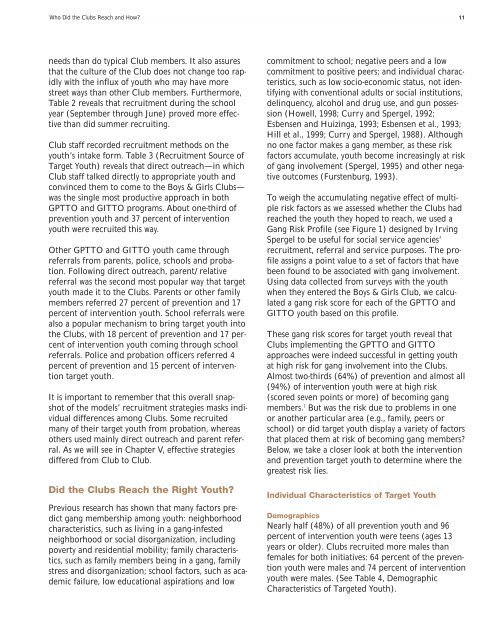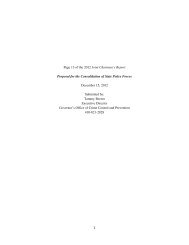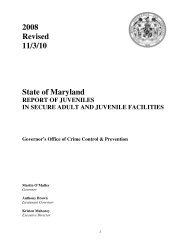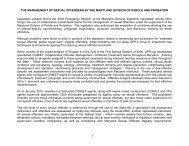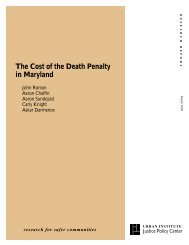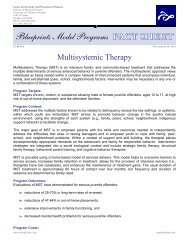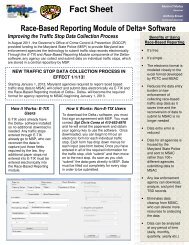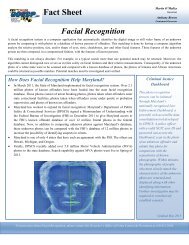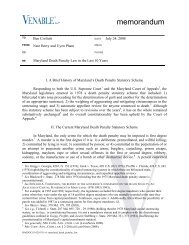Targeted Outreach - Governor's Office of Crime Control & Prevention ...
Targeted Outreach - Governor's Office of Crime Control & Prevention ...
Targeted Outreach - Governor's Office of Crime Control & Prevention ...
Create successful ePaper yourself
Turn your PDF publications into a flip-book with our unique Google optimized e-Paper software.
Who Did the Clubs Reach and How? 11<br />
needs than do typical Club members. It also assures<br />
that the culture <strong>of</strong> the Club does not change too rapidly<br />
with the influx <strong>of</strong> youth who may have more<br />
street ways than other Club members. Furthermore,<br />
Table 2 reveals that recruitment during the school<br />
year (September through June) proved more effective<br />
than did summer recruiting.<br />
Club staff recorded recruitment methods on the<br />
youth’s intake form. Table 3 (Recruitment Source <strong>of</strong><br />
Target Youth) reveals that direct outreach—in which<br />
Club staff talked directly to appropriate youth and<br />
convinced them to come to the Boys & Girls Clubs—<br />
was the single most productive approach in both<br />
GPTTO and GITTO programs. About one-third <strong>of</strong><br />
prevention youth and 37 percent <strong>of</strong> intervention<br />
youth were recruited this way.<br />
Other GPTTO and GITTO youth came through<br />
referrals from parents, police, schools and probation.<br />
Following direct outreach, parent/relative<br />
referral was the second most popular way that target<br />
youth made it to the Clubs. Parents or other family<br />
members referred 27 percent <strong>of</strong> prevention and 17<br />
percent <strong>of</strong> intervention youth. School referrals were<br />
also a popular mechanism to bring target youth into<br />
the Clubs, with 18 percent <strong>of</strong> prevention and 17 percent<br />
<strong>of</strong> intervention youth coming through school<br />
referrals. Police and probation <strong>of</strong>ficers referred 4<br />
percent <strong>of</strong> prevention and 15 percent <strong>of</strong> intervention<br />
target youth.<br />
It is important to remember that this overall snapshot<br />
<strong>of</strong> the models’ recruitment strategies masks individual<br />
differences among Clubs. Some recruited<br />
many <strong>of</strong> their target youth from probation, whereas<br />
others used mainly direct outreach and parent referral.<br />
As we will see in Chapter V, effective strategies<br />
differed from Club to Club.<br />
Did the Clubs Reach the Right Youth?<br />
Previous research has shown that many factors predict<br />
gang membership among youth: neighborhood<br />
characteristics, such as living in a gang-infested<br />
neighborhood or social disorganization, including<br />
poverty and residential mobility; family characteristics,<br />
such as family members being in a gang, family<br />
stress and disorganization; school factors, such as academic<br />
failure, low educational aspirations and low<br />
commitment to school; negative peers and a low<br />
commitment to positive peers; and individual characteristics,<br />
such as low socio-economic status, not identifying<br />
with conventional adults or social institutions,<br />
delinquency, alcohol and drug use, and gun possession<br />
(Howell, 1998; Curry and Spergel, 1992;<br />
Esbensen and Huizinga, 1993; Esbensen et al., 1993;<br />
Hill et al., 1999; Curry and Spergel, 1988). Although<br />
no one factor makes a gang member, as these risk<br />
factors accumulate, youth become increasingly at risk<br />
<strong>of</strong> gang involvement (Spergel, 1995) and other negative<br />
outcomes (Furstenburg, 1993).<br />
To weigh the accumulating negative effect <strong>of</strong> multiple<br />
risk factors as we assessed whether the Clubs had<br />
reached the youth they hoped to reach, we used a<br />
Gang Risk Pr<strong>of</strong>ile (see Figure 1) designed by Irving<br />
Spergel to be useful for social service agencies’<br />
recruitment, referral and service purposes. The pr<strong>of</strong>ile<br />
assigns a point value to a set <strong>of</strong> factors that have<br />
been found to be associated with gang involvement.<br />
Using data collected from surveys with the youth<br />
when they entered the Boys & Girls Club, we calculated<br />
a gang risk score for each <strong>of</strong> the GPTTO and<br />
GITTO youth based on this pr<strong>of</strong>ile.<br />
These gang risk scores for target youth reveal that<br />
Clubs implementing the GPTTO and GITTO<br />
approaches were indeed successful in getting youth<br />
at high risk for gang involvement into the Clubs.<br />
Almost two-thirds (64%) <strong>of</strong> prevention and almost all<br />
(94%) <strong>of</strong> intervention youth were at high risk<br />
(scored seven points or more) <strong>of</strong> becoming gang<br />
members. 7 But was the risk due to problems in one<br />
or another particular area (e.g., family, peers or<br />
school) or did target youth display a variety <strong>of</strong> factors<br />
that placed them at risk <strong>of</strong> becoming gang members?<br />
Below, we take a closer look at both the intervention<br />
and prevention target youth to determine where the<br />
greatest risk lies.<br />
Individual Characteristics <strong>of</strong> Target Youth<br />
Demographics<br />
Nearly half (48%) <strong>of</strong> all prevention youth and 96<br />
percent <strong>of</strong> intervention youth were teens (ages 13<br />
years or older). Clubs recruited more males than<br />
females for both initiatives: 64 percent <strong>of</strong> the prevention<br />
youth were males and 74 percent <strong>of</strong> intervention<br />
youth were males. (See Table 4, Demographic<br />
Characteristics <strong>of</strong> <strong>Targeted</strong> Youth).


